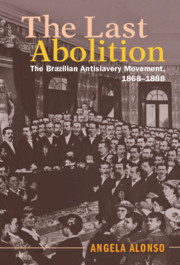Book contents
- The Last Abolition
- Afro-Latin America
- The Last Abolition
- Copyright page
- Dedication
- Contents
- Figures
- Maps
- Tables
- Acknowledgments
- Abbreviations
- Introduction
- 1 Elite Abolitionism
- 2 Pro-Slavery Rhetoric
- 3 The Moral Repertoire of Abolitionism
- 4 The Theatricalization of Politics
- 5 Expansion
- 6 Results-Based Abolitionism
- 7 Votes: A Movement/Government Alliance
- 8 Bullets: Movement and Countermovement
- 9 The March to Victory
- 10 Future of the Preterite
- 11 Abolitionism as a Social Movement
- Annex
- Bibliography
- Index
6 - Results-Based Abolitionism
Published online by Cambridge University Press: 24 September 2021
- The Last Abolition
- Afro-Latin America
- The Last Abolition
- Copyright page
- Dedication
- Contents
- Figures
- Maps
- Tables
- Acknowledgments
- Abbreviations
- Introduction
- 1 Elite Abolitionism
- 2 Pro-Slavery Rhetoric
- 3 The Moral Repertoire of Abolitionism
- 4 The Theatricalization of Politics
- 5 Expansion
- 6 Results-Based Abolitionism
- 7 Votes: A Movement/Government Alliance
- 8 Bullets: Movement and Countermovement
- 9 The March to Victory
- 10 Future of the Preterite
- 11 Abolitionism as a Social Movement
- Annex
- Bibliography
- Index
Summary
In 1883, abolitionists, led by José do Patrocínio, followed the North-American example, and launched a campaign for creating free soils. The strategy consisted of buying up freedom certificates or persuading slave owners to give them for free at intervals. The tactic did not work well in the capital of the Empire. Then Patrocínio joined the campaign in Ceará, selected for having small slave stocks, strong local abolitionist associations, and a provincial president willing to support the movement. Abolitionists went house to house, city by city, and started a countdown to province-wide abolition. Patrocínio traveled to Paris, where, as Nabuco in London, organized events to showcase the movement’s international support and embarrass the national government, thus preventing repression. In March 1884, abolitionists declared Ceará to be "free soil." On the eve of mobilization, Patrocínio and Rebouças created the Abolitionist Confederation, embracing all abolitionist associations all over the country, and launched a manifesto for the immediate and non-indemnified abolition of slavery. The Abolitionist Confederation continued the free soil campaign around the country and organized propaganda events in the public space, making abolitionist presence impossible to be ignored. This strategy caused a crisis in the political institutions and a growing pro-slavery reaction.
Keywords
- Type
- Chapter
- Information
- The Last AbolitionThe Brazilian Antislavery Movement, 1868–1888, pp. 178 - 225Publisher: Cambridge University PressPrint publication year: 2021



